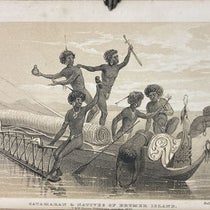Scientist of the Day - Christen Smith
Christen Smith, a Norwegian botanist and explorer, was born Oct. 17, 1786, in a town about 25 miles southwest of Oslo. He attended the University of Copenhagen (Norway and Denmark were then a single country), where he studied medicine and botany. After graduating, he hiked his way through the mountains of Norway, collecting plants, and then travelled to visit the great botanical gardens of Europe. While in England, he met the great Prussian geologist Leopold von Buch, who got him excited about rocks and volcanoes.
Von Buch was planning to study the volcanism of the Canary Islands and invited young Smith, who must have shown considerable promise, to come along. Smith jumped at the chance, spent a year in the Canaries and Madeira, and brought back hundreds of plant specimens, many of them new to science.
Someone at the Royal society in London was impressed, probably the President and fellow botanist Joseph Banks, who had collected an impassive number of new plants on James Cook's first voyage in 1769. Banks was also head of the African Association, which for nearly 30 years had been sponsoring expeditions to Africa, with precious little to show for it, except for dead explorers. Now they wanted to send a party up the Congo River to see where it went – no one knew. They had a ship, the HSS Congo, and a Captain, James Tuckey, and they needed a botanist and geologist, and Smith was now both, so he was offered the position. One hopes they informed him of the health dangers facing Europeans who ventured into tropical jungles. Poor Christen. He had already accepted a position at the new University in Oslo (Norway had now split from Denmark), with its new botanic garden, and he had not set foot in Norway for two years. Little did he know he would never see home again.
The HMS Congo was a steamship, the first in the Royal Navy. It was powered by a Watt & Boulton steam engine, which was so heavy that with it onboad, the ship could make no headway. So they removed the engine, rigged it with sails, and sent it off anyway, even though I was much too robustly built for river sailing. It turned out to be useless on the Congo, and the expedition party had to rely on a second, smaller ship, which could only make it 100 miles up the Congo before it was defeated by rapids. The explorers proceeded by foot, and one by one, they were struck down by "the fever," which everyone presumes was yellow fever, but we don't know. Christen and the Captain both came down with fever, and both made it back to the mouth of the Congo, where Christen was able to pack up his herbarium and ship it to Oslo before succumbing to his sickness on Sep. 22, 1816, just 30 years old. Capt. Tuckey died 12 days later. What a waste of young talent!
Tuckey's log was saved, and a narrative of the disastrous expedition was published in 1818, with an added account by Smith taken from his journal (second image). We do not own this book, and I have never seen a copy, except online. The map of the mouth of the Congo is impressive, and we include that engraving here (third image), taken from a copy at the University of California, Berkeley.
Smith's herbarium made it back to the Botanic Garden in Oslo, where his specimens were eventually incorporated into the Natural History Museum when that institution was later founded. They are still there, and his successors as professor of botany in Oslo still use them, and are proudly photographed with them (fourth image). Smith is a highly respected figure in Norway, usually coupled with Niels Abel, the Norwegian mathematician who died of tuberculosis at age 26, as examples of shining lights that were snuffed out much too soon.
William B. Ashworth, Jr., Consultant for the History of Science, Linda Hall Library and Associate Professor emeritus, Department of History, University of Missouri-Kansas City. Comments or corrections are welcome; please direct to ashworthw@umkc.edu.










